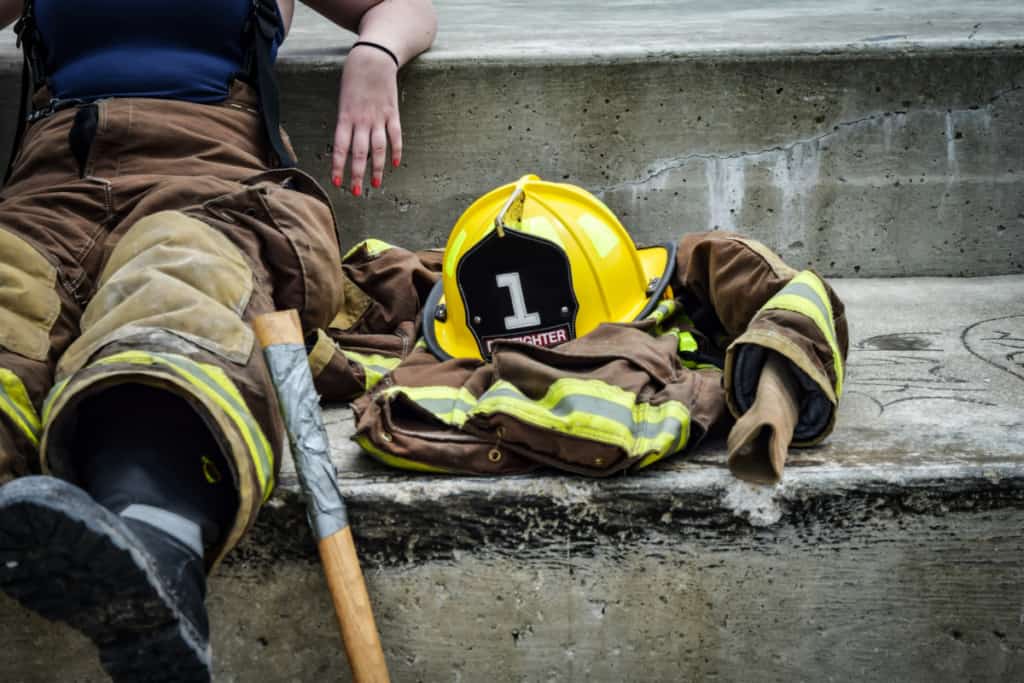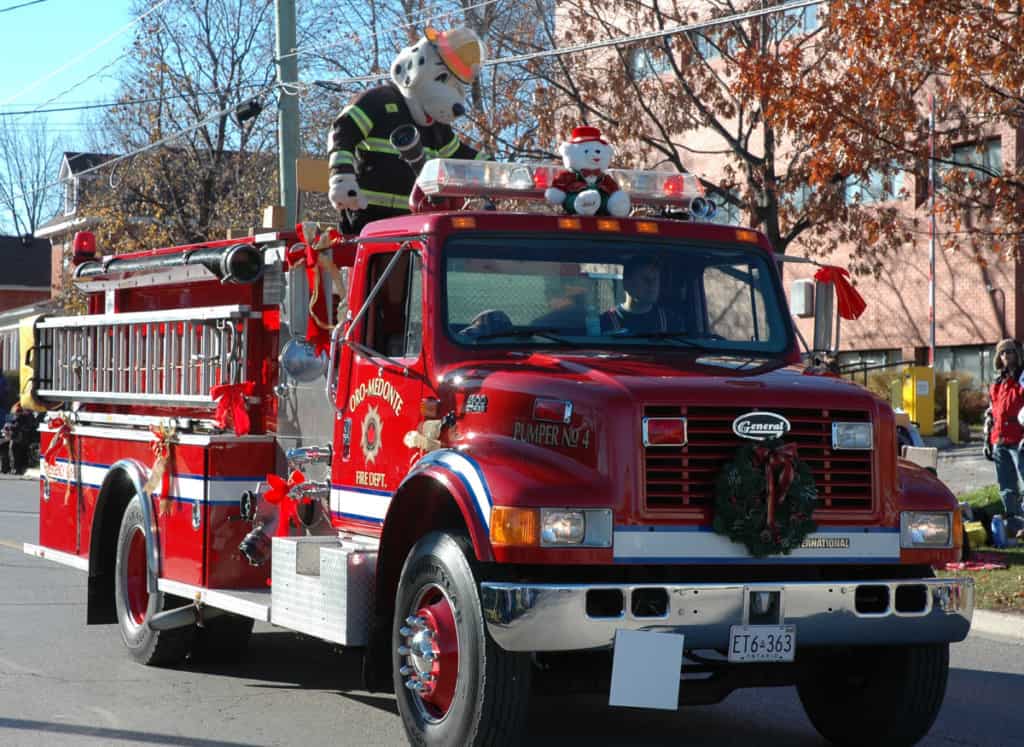Thinking about becoming a firefighter? Wondering just how hard the CPAT test is and whether you really have to wear that weighted vest while you do it? Well, you’re in the right place. Yes, you will have to wear that vest and as to whether it’s hard… that very much depends on you.
To train for and pass the stair climb event of the Candidate Physical Ability Test (CPAT), you should use a weighted vest to simulate the added load of the test and of work of being a firefighter. You should also take advantage of the CPAT orientation days.
The CPAT and especially the stair climb event can be challenging and it seems to give people the most anxiety. However, if you take the time to adequately prepare yourself, it is very doable. You can pass! Keep reading for some good tips and advice to get you through this test.
Your # 1 priority is keeping your family safe. As a firefighter, I recommend everyone has updated smoke detectors that don’t require battery changes, like these ones from Kidde, a fire extinguisher, like this one from Amerex, and a fire escape ladder if you have bedrooms above the first floor, I recommend this one from Hausse.
Also read: The Fitness Requirements for a Firefighter – Explained
What Is The CPAT?
The CPAT is a physical fitness test (Candidate Physical Ability Test) which is designed to measure whether an individual can cope with the demands placed on their body as a firefighter. It is a timed event and includes 8 tasks in total – each one is designed to mimic a task that is carried out on the job.
Those 8 tasks are as follows:
- Stair climb
- Hose drag
- Equipment carry
- Raising and extending a ladder
- Forcible entry
- Search
- Rescue drag
- Ceiling breach and pull
This video shows what the CPAT events are like:
Now, it’s fair to say that the tests would be easier if it wasn’t for one thing – you have to wear a CPAT weighted vest during the tests (to simulate heavy firefighting gear) and that makes them much, much more challenging than they might first appear.
For information on the CPAT and how to train and prepare for each event, read: 8 Tips for the Firefighter Physical Test: Passing the CPAT
Here is a PDF document that covers all the event instructions: CPAT PDF
How Much Does The CPAT Vest Weight And Why?
On the day of the test, you will be expected to wear a vest weighing 50 lbs. plus a helmet and gloves. This is designed to ensure that the tests reflect that in the real world – you working in full personal protective equipment (PPE) as a firefighter and it is very heavy.
Oh, and if that wasn’t enough extra weight, when it comes to doing the stair climb, you’re going to find yourself treated to an additional 25 lbs. (12.5-pound shoulder weights on each shoulder – velcro to the vest).
That’s to simulate climbing upstairs for a fire, where you are also carrying a hose pack or tools most of the time.
Is The CPAT Test Hard?
Bluntly, the CPAT test is only going to be hard, if you are unprepared for it.
If the first time you do a bit of exercise in your life is at the CPAT – good luck with that. In general, those who train hard for the CPAT and ensure that they are at a solid level of fitness shouldn’t struggle that much with it.
Anecdotal reports from CPAT examiners suggest that failure rates are low and that they can normally tell who is going to fail pretty quickly. Thus, a lack of physical preparation tends to be pretty obvious to everyone around you.
If you take the time to train and prepare, you should be able to pass the test.
Note: One thing some people don’t realize is that just because you are fit enough to pass the CPAT, that doesn’t necessarily mean you are ready to pass the fire academy and function as a firefighter.
Many fire academies are much more physically strenuous than the CPAT. I urge you to get yourself in the best firefighting shape possible before you are hired/start an academy, which usually means more than just CPAT test ready.
CPAT Weighted Vest Stair Climb: How To Train
Firstly, before you start training – you will be given an opportunity to attend a CPAT orientation session. In this session, you will be given the opportunity to try out all the equipment and be given a thorough briefing as to what will be expected of you during the test itself.
It should come as no surprise at all, but people who attend these orientation sessions are much more likely to pass the CPAT then those who don’t. And don’t worry about this costing you a small fortune – the session is included in your CPAT fee, you’re going to pay for it whether or not you attend.
Take advantage of this opportunity.
The stair climb event is usually one of the more difficult for most people.
You are carrying a significant amount of extra weight (75 pounds), you are not allowed to hold onto the handrails, and you must climb at 60 steps per minute (one per second) for 3 minutes. This doesn’t sound very fast, but your legs will probably start to burn with the added load.
Even though I was more than prepared and passed the test with time to spare, I remember my legs feeling like “Jello” after this event, which definitely adds a challenge to the rest of the test.
In order to train effectively for the CPAT, I really recommend getting a weighted vest (we’ve got our recommendation for this below) because that’s what you’re going to take the test in.
Training without one may not cut it, because the extra weight is so significant (particularly during the stair test) that if you aren’t used to carrying it, you may find it difficult.
This is not a requirement, but it really does make things easier.
Not just for the CPAT test, but a weighted vest is super helpful for firefighter physical fitness. It can be very useful for helping you get used to working with all the added weight a firefighter must wear and carry.
Then you should undertake a sensible program of overall fitness training for the CPAT and the good news is that there’s a full in-depth guide to this published online and it’s free. You don’t need to pay for this.
As a quick summary, the training is broken down into five areas:
- Warm-up exercises and stretching – if you don’t do this before any kind of exercise, you’re asking for an injury
- Weight training circuits – this helps you to build the muscle required to carry that extra weight
- Calisthenics training circuits – this helps you to build the stamina required for the test
- The CPAT running program – running is one way to build endurance and cardio fitness, but not the only way
- Task-specific exercises – that’s right there are different exercises for each of the 8 different parts of the test that you will be required to undertake.
We would note that for a small additional fee, you can also normally take a CPAT practice test and if you don’t feel confident that you’re ready for your CPAT, this can be a very good way to identify your weaknesses so that you can practice them.
For the stair climb in particular, I recommend training as follows:
How To Pass The CPAT Stair Climb
The hardest part of the CPAT test is the stair climb, but it’s quite simple to train for.
You will undertake a 3-minute stair climb on stairs of approximately 8-inches in height.
So, find a similarly sized-step (doesn’t need to be perfect) and then complete 24 stepping cycles a minute – this is where you put one foot on the step, then move the other, then move the first foot off the step, and then the second. You are aiming for two cycles every 5 seconds. Make sure to switch which foot steps up first to train each leg equally.
If you have access to a stair-stepper machine, stadium steps or multi-story building staircase, use those to train. The tips above are for someone who doesn’t have a larges enough staircase nearby.
Start this training unweighted and go for 5 minutes.
Then as you become fitter, add a second set of 5 minutes (with a rest in between 5 mins or so) and then a third set.
Once you master that, you can start to add weight. I would get a 50 to 70 pound vest and you can remove some weight pouches to get the desired starting weight.
Start with 20lbs, then move to 30 lbs. the to 40, 50 and then 60, or 70.
The vest that I used and still use for firefighter specific fitness training is this one made by Cross101. They have a variety of weights (20 to 140 pounds), I have the 60-pound vest.
I know these aren’t cheap, but in my opinion, they are totally worth it. A small price to pay to help you prepare for your dream job. And if you buy a good quality vest, it should last for years. (I have been using mine for quite a long time and it is still in great shape.)
A weighted vest is the best tool for this, but if you really can’t afford it you can make your own. Here is a video of how you could go about making your own vest for cheaper:
What Is The Best Weighted Vest To Train For The CPAT? Cross101 Weighted Vest
Cross101 is the best value weighted vest I have found.

I’m sure there are other good vests, but this is the one I have used and had the best experience with in terms of durability and comfort.
It comes with a pocket for a phone (or iPod), a water bottle holder (though I don’t use this), and also a velcro belt that allows you to adjust how snug it fits.
Regardless of which weight you choose, the weights can be adjusted with removal sandbag pouches. This allows you to use different loads for different workouts and allows you to build up to the heavier weights as you get in better shape.
You can find the Cross101 60-pound Weighted Vest (the one I use) on Amazon here.
Conclusion
We hope that our guide to the CPAT weighted vest stair climb has been helpful and that you now have a good idea of what to expect when you take the CPAT test. The test is a good simulation of what it will be like to be a firefighter and it’s not meant to be hard – it’s meant to ensure that you are up to the job for your own safety and the safety of those around.
So, if you want to pass the CPAT, really all you need to do is make sure that you practice hard and that you’re in shape on the day. So, attend the preparation sessions, consider taking a practice test and make sure to train using a weighted vest, so that all that extra weight on test day doesn’t come as a surprise to you.
Related Articles:
How Hard is the Fire Academy? Are You Ready?

